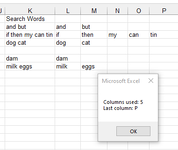tonywatsonhelp
Well-known Member
- Joined
- Feb 24, 2014
- Messages
- 3,194
- Office Version
- 365
- 2019
- 2016
- Platform
- Windows
Hi Everyone,
bit of a Saturday morning challenge for you
In Column K I have a list of cells that contain search engine sentences.
So Row 1 is the Header "Search Words"
and it can be any amount of rows.
So What i'm looking for is a macro that can split up my words into their own columns.
now the problem is I don't know how many words this is as there can be just 1 or several,
So heres what I'd like please help if you can.
A Macro that when run seperates column K using the text to columns method spliting at spaces,
Then I simply need it to tell me how many columns where used and what the last column is
for example msgbox" Your data was split acrros 21 columns with the last column being AA!" for example
please help if you can
Thanks
Tony
bit of a Saturday morning challenge for you
In Column K I have a list of cells that contain search engine sentences.
So Row 1 is the Header "Search Words"
and it can be any amount of rows.
So What i'm looking for is a macro that can split up my words into their own columns.
now the problem is I don't know how many words this is as there can be just 1 or several,
So heres what I'd like please help if you can.
A Macro that when run seperates column K using the text to columns method spliting at spaces,
Then I simply need it to tell me how many columns where used and what the last column is
for example msgbox" Your data was split acrros 21 columns with the last column being AA!" for example
please help if you can
Thanks
Tony






